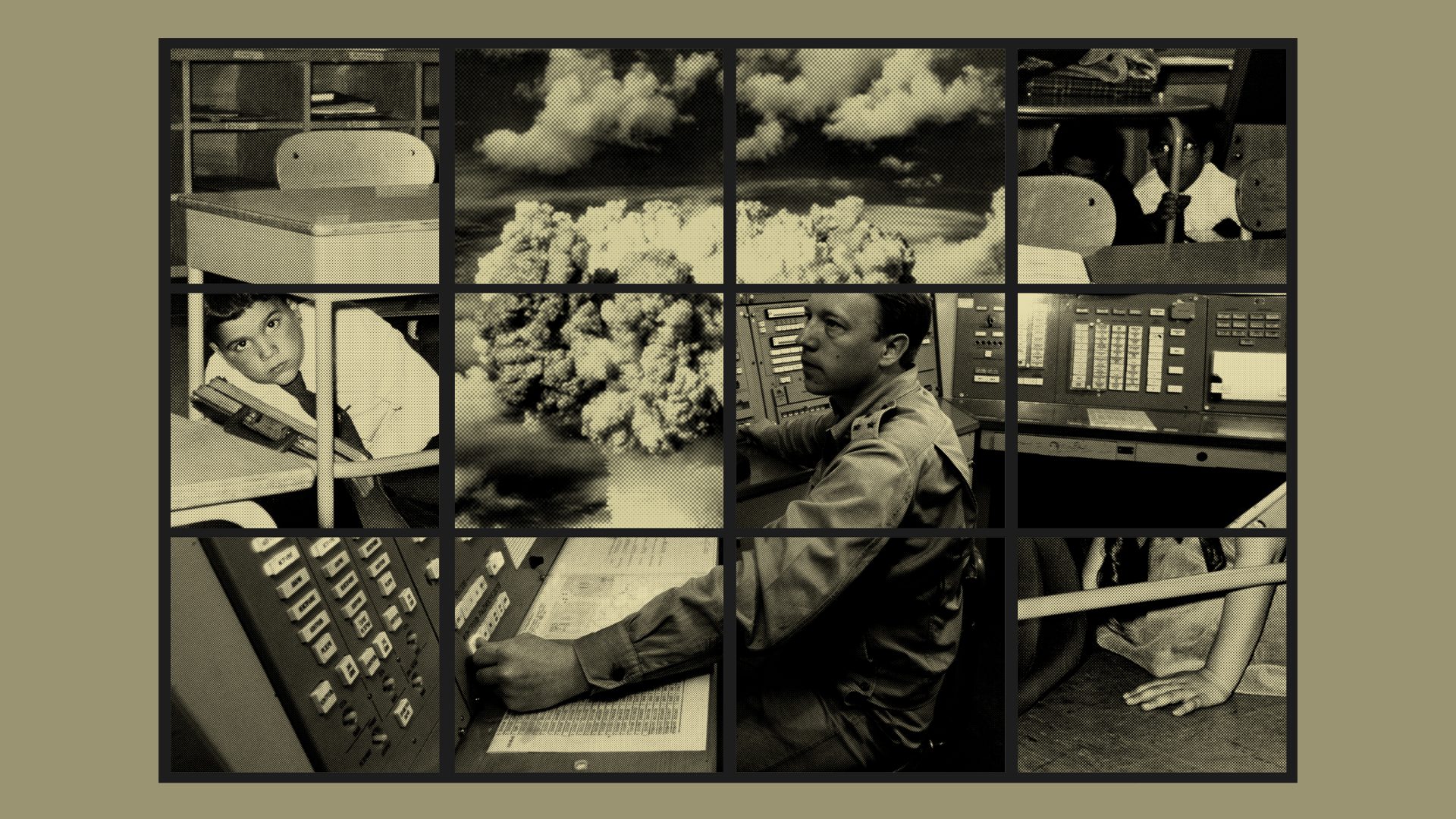It was one of the few occasions that I had to applaud Boris Johnson. In May, while Russian TV was ramping up nuclear threats and showed simulated attacks on the UK, he called Vladimir Putin’s hints at nuclear escalation a “distraction from what is really going on: a savage attack with conventional means on innocent people”.
I hope Johnson’s successor will keep calm, too. Especially because in Germany, the angst is back. An increasing number of my countrymen fear a third world war. Thanks to Russian rhetoric, but also due to our Bundeskanzler and other Social Democrats making comparisons with 1914 and warning about “sleepwalking” into another war, because “there must not be a nuclear war”.
As a rather unexpected result, Germans have suddenly learned to love the bomb: for the first time in decades, polls show a majority (52%) in favour of the US nuclear weapons arsenal in Germany. The biggest support (64%) comes from Green Party voters, formerly known as pacifists.
Germans don’t want to own nukes, nor do we want to produce them. But since Russia’s war on Ukraine we have suddenly grown fond of the 20 or so US nuclear bombs unofficially stored in concrete vaults in the west of Germany, deep below the ground.
Until last year, nuclear deterrence had been labelled obsolete by the German left. But overall, US nukes are very much in vogue again.
What isn’t equally popular, but should be, is an informed discourse across nations and people on whether and how to innovate the nuclear release process. Heaven forbid they are ever used. Yet from Washington DC to Beijing, the protocols which lay down the process of how the nuclear button is pushed date back up to 70 years, with only minor changes.
Germany isn’t a nuclear power. So most people don’t realise that the B61 free-fall bombs at Büchel Air Base would be carried to their target by a Luftwaffe jet. Not by an American pilot but by a German one, who would then release a bomb 13 times deadlier than the one used in Hiroshima in 1945, which killed 140,000 people.
This is so-called nuclear share: only the US president can authorise the launch (he has the codes), but the Bundeskanzler needs to agree, as does Nato command. Interestingly, even among more expert circles in Berlin, this scenario isn’t really discussed.
I recently came across the reason why when listening to the neuroscientist Dr Moran Cerf at the DLD conference on innovation, digital media and science in Munich: our brain has a hard time thinking about high-risk, low-probability events, such as a nuclear attack or response. “Our world is not aligned with our brain,” says Cerf. “Back then, it evolved to think about the near future, to grasp small-scale events.”
Cerf is a neuroscience and business professor at Northwestern University’s Kellogg School of Management in Chicago. Funded by the Carnegie Corporation, he spearheads a project across multiple institutions to review the nuclear launch protocols and suggest better ways to operate in light of new knowledge from behavioural economics, decision-making and neuroscience.
The international team of academics and military experts have been working on “nuclear threats innovation’’ for seven years to cut the risk of weapons use (and accidents).
I asked Cerf what concerns him most. He replies that for a decision of such enormous consequence, “we have so little theory about the mind of the one person making the choice”. He describes how he, the outsider in the nuclear sphere, would pose simple questions about the protocols to admirals, colonels, expert civilians and often be told: “We never thought of that.”
Nuclear deterrence theory and the protocols are based on the assumption that a credible, rational actor will take the ultimate decision. In other words, there’s no scenario that includes a commander-in-chief throwing his lunch against the White House dining room wall. Or a president sitting at a super-size table in the Kremlin, isolating himself from most of the world for two pandemic years.
All nuclear powers share the so-called two-men rule: at the various stages of a nuclear-related procedure there must always be two people to verify authority and to execute simultaneous moves, like inserting two codes or turning two keys.
Apart from Pakistan, however, it is also true that the full burden of responsibility to decide on large-scale nuclear destruction falls on a single person (Putin placed himself in sole command in 2020). And this person’s brain may be influenced by parameters not included in nuclear response scenarios. Would Emmanuel Macron decide differently if he were Joe Biden’s age? Has North Korea’s supreme leader Kim Jong-un had a good night’s sleep? Does Putin really receive all the information he needs?
Cerf points to neuroscience proving that people make completely different decisions when hungry or tired. Our brain, he says, is influenced by age, biases, cognitive capabilities, personality type – and urgency.
In the UK, the firing line reaches from the prime minister and two nuclear-authenticated officers next to him with the cryptography to encode messages, to the nuclear operations targeting centre several floors beneath the Ministry of Defence’s main building in Whitehall, to the Trident command post at Northwood, to one of the Vanguard submarines on roundthe-clock, at-sea deterrence. For the PM’s launch instruction to reach the submarine on patrol, for it to be authenticated, and then for the first Trident missile to be launched, it would take around 60 minutes.
In the US, according to protocol, the current scenario of nuclear retaliation takes 15 minutes. The “launch on warning” strategy allows for a retaliatory nuclear weapons strike as soon as satellites and other warning sensors detect an incoming enemy missile – no need to wait for an impact.
Two years before his death in 2020, Bruce G Blair, a nuclear security expert and advocate for the elimination of nuclear weapons, summed up the “thermonuclear monarchy” as follows: “The president wakes up, gives an order through a system so streamlined that there’s almost no gatekeeping, and, within five minutes, 400 bombs leave on missiles.”
Blair added: “It takes only about one minute for a Minuteman crew in the plains states of the Midwest to carry out their launch checklist. This was my job in the 1970s and, at the time, it took me one minute.” And changing the target from peacetime (the ocean) to wartime (Moscow or any other aim) is “as easy as changing the channel on your TV set”, he said.
Cerf half-jokes about the briefcase, the so-called “football”, to be used by the US president to authorise a nuclear attack while away from the White House: “Among the contents is a book, with all the options. Experts tell us, it’s thick enough to make it unlikely that a president can actually spend time reading it and making an informed decision in the short time and high stress they are undergoing.” No wonder experts are calling for a reform of the launch protocol to provide more warning and decision time. “If I could change only one thing in the US protocol, it would be to remove the 15 minutes time frame,” says Cerf.
He points to a virtual reality experiment conducted by his colleague Sharon Weiner and Moritz Kütt during the Munich Security Conference in early 2020: more than 100 senior government officials, diplomats, security experts and civilian leaders used a VR headset to assume the role of US president in a nuclear weapons crisis.
After receiving the proverbial 3am phone call, they had the real-life decision-making window of 15 minutes to consult advisers and decide what action to take.
According to the neuroscientist, the vast majority of the participants did react in a human (not humane) way: “After being told that nuclear missiles are maybe coming and that maybe we’re going to die, their response was to launch one back. They felt that not doing anything would be a failure.”
Interestingly, Cerf adds, “many of them did it within five minutes. So you’re told you have 15 minutes, time to get information, ask, question, learn. There’s no point in being early, but they were.”
There are real simulations, too. The airmen in Minot, North Dakota, who keep the missiles on alert, rehearse almost every day, as Cerf witnessed. Inspectors show up for random checks. “The secretary of defence and his staff also rehearse, mostly things like who speaks when and what’s the most concise way I can give the president information?”
Does the president rehearse? Cerf says: “They’re supposed to, every three months. They don’t.”
If you believe Cerf, Jimmy Carter was the last president to have taken the time to regularly and properly train for a nuclear weapons response. He says: “The war games are rehearsed by military people. The civilians are not showing up.”
It would be very wrong to assume this is just the case in the US.
Given this context – protocols relying on rational, trained decision-makers while in real life they are neither – Cerf, daringly, suggests outsourcing parts of the decision-making process to artificial intelligence. He describes the moment when he floated this academic idea to members of the US military and the Biden administration during a first meeting. Everyone in the room seemed to have “seen Terminator and said ‘absolutely not. Never going to happen. We’re not going to put AI in control’.”
What ensued was a game of sorts: with every AI flaw mentioned, “we showed that a similar mistake is 10 times more likely with humans. Bugs in AI? Humans have bugs, too: irrational behaviour. We are the only animals that delay sleep, which is bad for us. Humans like to have control. But when left to our own devices, we constantly make mistakes.”
Near-nuclear escalation incidents (the latest one: India firing a missile at Pakistan by mistake in March, then not confirming the accident for 48 hours) and security breaches (US military personnel using publicly accessible apps to memorise codes and the exact number, status and location of nuclear weapons) support Cerf’s point. But replacing the person in the room with a machine won’t happen.
There are easier suggestions that resonate – improved communication among all nuclear powers, for instance. Apparently, the Pentagon would like to see all nuclear silos connected, so when the silo door is open in any country, all the others will know. A deterring factor, maybe.
Cerf won’t let go of AI though. He concedes that Trump did improve deterrence by seeming crazy enough to hit the button (side note: experts here fear a re-election of Trump exactly because he may be crazy enough NOT to hit the button if a European country is under attack).
So the system “weirdly requires some noise” – a noise that smart, rational people in charge and an even smarter, more rational AI may not produce.
But what about a self-help system, fed with data coming from the president himself, the prime minister, the supreme leader? Cerf’s idea is this: in the first week of taking office, the elected head of state or government would take half a day to “sit in a room and play those war games, taking hundreds of choices. When to launch, when not to launch. We then train the machine until it accurately predicts the leader’s individual choices. So then we have, like, Biden-in-a-box sitting in the office next to the president – and he can ask the digital version of himself: ‘what would I do?’”
The only difference would be that in an actual nuclear threat, Biden-in-a-box would not be worried about where his family is, would not be tired or hungry, and under no time pressure. Or, Cerf goes on: “Imagine the same box with all the presidents. So I can say, give me the advice of Obama.”

In a way this is what David Cameron did in May 2010 when he sought John Major’s advice on what order to write into the sealed Letters of Last Resort, a unique UK-procedure to brief submarine commanders once the prime minister and his nuclear deputies have been incapacitated.
The options for the orders are said to have contained: “place yourself under the command of the US, if it is still there”; “go to Australia”; “retaliate”, “use your own judgment”, “commit the forces”, “do not commit the forces” and “make the most reasonable choices”.
Coming back to his project – reforming nuclear protocols in nine countries – Cerf doesn’t pretend to be an idealist. “No one country will implement anything solely.”
At the start he had little hope of any significant impact. But now, he says, with war in Ukraine, “the urgency rose and I realised there’s an increased chance that things will have some more concrete outcomes.




